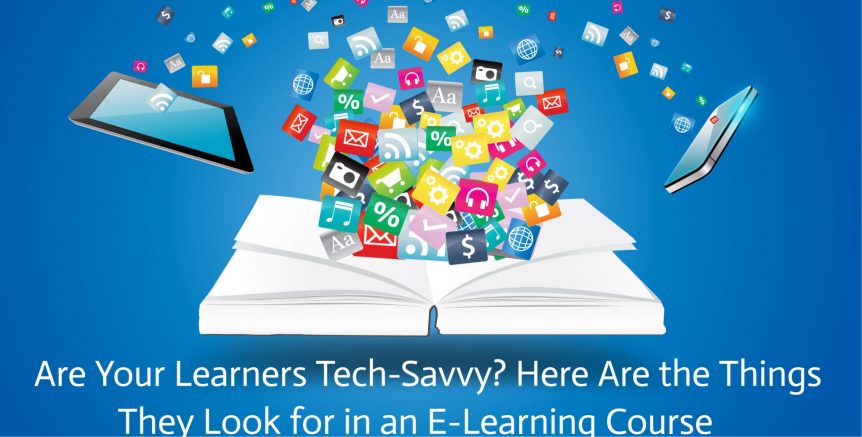Are Your Learners Tech-Savvy? Here Are the Things They Look for in an E-Learning Course
There is a lot of content available that gives you tips and advice on how to engage learners who don’t like using technology to ensure your e-learning modules are successful. It’s often assumed, however, that tech-savvy learners don’t need the same attention.
After all, you’re delivering learning to them using technology, and they like and feel comfortable using tech. Job done, right?
Not quite. In fact, it can actually be more difficult to engage tech-savvy learners than those who don’t like using tech. This is because tech-savvy learners are likely to have higher expectations, so are more demanding and less forgiving.
Tech-Savvy Doesn’t Necessarily Mean Millennial or Generation Z
Before going further, the term tech-savvy in relation to this blog has no relation to the common method of grouping people according to their age. Using this method, young people (generation Z-ers and millennials) are more comfortable using tech than older people (generation X-ers and boomers).
The problem with this approach, however, particularly in relation to learning, is that young doesn’t always mean tech-savvy and old doesn’t always mean tech-reluctant. So, for this blog, we are focusing entirely on those who feel comfortable using technology and who use it regularly, whatever their age.
Cross-Device Compatibility
Tech-savvy learners want to be able to complete courses on the device of their choosing. Remember, people that use tech a lot are used to having all their devices synced where they can, for example, start watching a movie on their phone and then continue on their TV when they get home.
Therefore, your e-learning modules should be responsive to ensure they work on all devices – computers, phones, and tablets.
Professional but Not Corporate
Your e-learning modules need to be slick and professional to appeal to tech-savvy learners, but be careful you don’t stray into visuals, tone, pace, and message that come across as overly corporate.
Corporate messages are not personal, so they don’t work well in e-learning modules. The better approach is to be more personal and to relate to the learner.
Personalised Learning Paths
All learners, tech-savvy or not, will understand their strengths and weaknesses. Tech-savvy learners, however, will have less patience if they are forced to complete sections or modules where they believe they already have a level of competence.
The solution is to make it possible for learners to develop their own learning paths, within the parameters you set, of course.
Offering learners personalised learning paths has a range of benefits, but it’s an approach that engages tech-savvy learners as well.
Clean and Uncluttered Designs
Cluttered, busy designs with disjointed fonts, unusual layouts, and/or colour schemes that jar will frustrate tech-savvy learners. Modern design is clean, free from distraction, and where less is more. You should ensure the design of your e-learning module meets these criteria.
Fast Loading Times
In the online world, speed is a very high priority. Therefore, you risk frustrating learners if your content takes too long to load.
You will probably have to take advice from a professional e-learning developer in Dubai on how to optimise your e-learning courses for speed, but this is an important step to take.
Intuitive Navigation
Tech-savvy learners know how to navigate around technology. However, there are best practices and common ways of doing things when it comes to navigation and structure. If you stray too far from these best practices and common approaches, you risk confusing even the most tech-savvy of learner.
Therefore, make sure your e-learning module’s navigation is well-planned out and intuitive.
Video
Video is a must for the tech-savvy learner, as they are used to watching videos in a range of different situations. This includes in work and learning situations where videos are used to improve, learn new skills, understand processes, etc.
That said, the videos you include should have features that appeal to tech-savvy learners. They shouldn’t be too long for a start, they should look professional, and they should include closed captions or subtitles.
The latter is essential for learners with hearing difficulties, but all learners can benefit from closed captions and subtitles. This is because learners can watch videos without the sound on when closed captions or subtitles are included.
Gamification Elements
Games are another application of technology that tech-savvy learners will be highly familiar with using. Of course, gamification elements will be beneficial for all your learners, but they are of particular importance for those comfortable with using technology.
Taking this a stage further, adding as many interactive elements to your e-learning modules as possible will help you engage tech-savvy learners. Interactive videos are a good example, as are scenarios.
Social Elements
The final point on this blog is another application of technology that tech-savvy learners are extremely comfortable using. So, a great way to engage them is to include social elements in your e-learning courses.
The ability to share progress is one example, or you could create a leader board that is shared on social media and adds a sense of fun competition to the learning experience.
Optimising for Tech-Savvy Learners Will Improve Your E-Learning Courses Overall
None of the points above will alienate learners who are not comfortable using technology. In fact, all learners completing your course will benefit from the implementation of the above points. They are particularly beneficial to tech-savvy learners, though.
